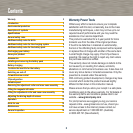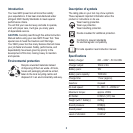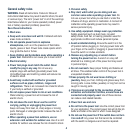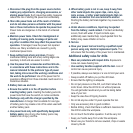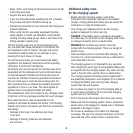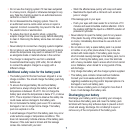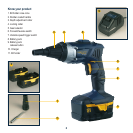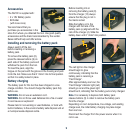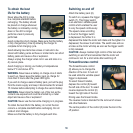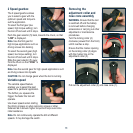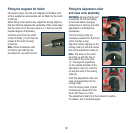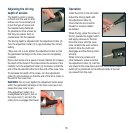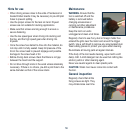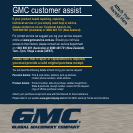7
• Do not use the charging system if it has been subjected
to a heavy knock, dropped or otherwise damaged in any
way. Take the charging system to an authorised service
centre for a check or repair.
• Do not disassemble the charging system. Take it to
an authorised service centre when service or repair is
required. Incorrect re-assembly may result in the risk of
fire, electric shock or electrocution.
• To reduce the risk of an electric shock, unplug the
adaptor charger from the power supply before attempting
to clean it. Removing the battery alone does not reduce
the risk.
• Never attempt to connect two charging systems together.
• Do not store or use the tool and battery pack in locations
where the temperature may reach or exceed 40°C such
as alongside sheds or metal structures in the summer.
• The charger is designed for use from a standard
household electrical supply (230 volts). Do not attempt
to connect the adaptor charger to a supply with a
different voltage.
Additional safety rules for the battery pack
• The battery pack for this tool has been shipped in a low
charge condition. You should charge the battery pack fully
before use.
• To ensure the longest battery life and best battery
performance, always charge the battery when the air
temperature is between 18–24°C. Do not charge the
battery pack when the temperature is below 4°C, or above
40°C. This is important. Failure to observe this safety rule
could cause serious damage to the battery pack.
• Do not incinerate the battery pack even if it is seriously
damaged or can no longer hold a charge. The battery
pack can explode in a fire.
• A small leakage of liquid from the battery pack may occur
under extreme usage or temperature conditions. This
does not necessarily indicate a failure of the battery pack.
However, if the outer seal is broken and this leakage
comes into contact with your skin:
- Wash the affected area quickly with soap and water.
-
Neutralise the liquid with a mild acid such as lemon
juice or vinegar
If the leakage gets in your eyes:
- Flush your eyes with clean water for a minimum of 10
minutes and seek immediate medical attention. Inform
the medical staff that the liquid is a 25Ð35% solution of
potassium hydroxide.
• Never attempt to open the battery pack for any reason.
If the plastic housing of the battery pack breaks open
or cracks, immediately discontinue its use and do not
recharge it.
• Do not store or carry a spare battery pack in a pocket
or toolbox or any other place where it may come into
contact with metal objects. The battery pack may be
short circuited causing damage to the battery pack, burns
or a fire. If storing the battery pack, cover the terminals
with a heavy insulation tape to ensure short circuit cannot
occur. Batteries, when stored for a long period of time,
will discharge.
• Only charge the battery with the charger system supplied.
• This battery pack contains nickel-cadmium batteries.
Consult your local waste authority for information
regarding available recycling and/or disposal options of a
damaged or worn-out battery pack.
• Do not leave a battery pack on charge for more than 8
hours. It will damage the battery cells.
Discharging your battery
Discharge your battery pack by operating your screwgun,
then remove the battery pack and cover the battery pack
terminals with heavy duty adhesive tape to prevent a short
circuit and energy discharge. Do not attempt to open or
remove any of the components of the battery pack.




